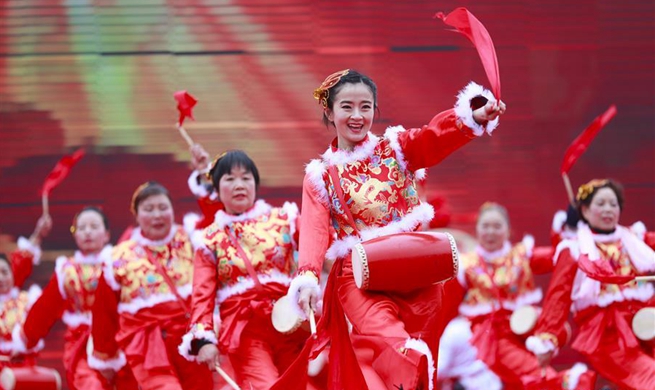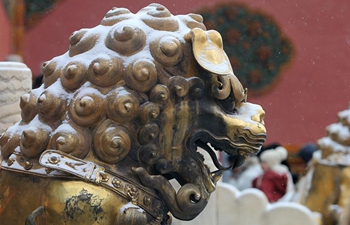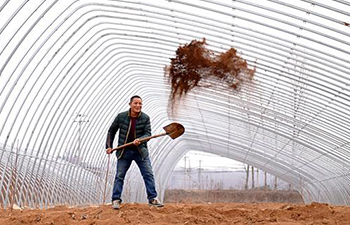BEIJING, Dec. 20 (Xinhua) -- As 2018 draws to an end, China is set to deliver solid economic results, offering much-needed certainties and opportunities to a world mired in uncertainties.
Despite external headwinds, China has maintained stable economic growth, minimized financial risks, pushed forward with reforms and fostered new growth drivers for longer-term development.
As policymakers map out economic plans for 2019, a review of the country's achievements in 2018 will give a glimpse of where the world's second-largest economy could be heading.
STABLE GROWTH
China's economy expanded 6.7 percent year on year in the first three quarters, above the government's target of around 6.5 percent set for the year.
The economic growth has stayed within a reasonable range, said Mao Shengyong, spokesperson of the National Bureau of Statistics, adding that China will no doubt achieve its full-year growth target.
Employment remained stable, with the surveyed unemployment rate in urban areas dipping to 4.8 percent in November, while consumer inflation was kept at a mild level of 2.2 percent last month.
In an October forecast, the IMF maintained its projection for China's 2018 growth at 6.6 percent, but cut its global growth forecast to 3.7 percent, down from 3.9 percent projected in July, citing rising downside risks to the global economy.
The stable growth came as the country nimbly maneuvered its policy mix, including the proactive fiscal policy, prudent and neutral monetary policy and targeted measures to support small businesses.
Rather than across-the-board rate cuts and reserve requirement ratio adjustments, the central bank has maintained the "two-pillar" policy framework, which includes monetary policy and macro-prudential policy, and relied more on the use of liquidity-managing tools, such as reverse repos and the medium-term lending facility, to fulfill increasingly delicate tasks.
To ease enterprises' burden, the country has taken solid steps to reduce taxes and fees, including reduction of value-added taxes as well as working on tax exemptions for small firms and technology startups.
RESILIENCE, SUSTAINABILITY
Although some November indicators revealed stress in the economy, sifting through the data exhibited strong resilience - a desired structural shift is afoot.
In just two minutes on the country's Singles' Day, shoppers smashed over 10 billion yuan (1.45 billion U.S. dollars) on e-commerce giant Alibaba's online platforms. The 24-hour sales amounted to a record of 213.5 billion yuan, exceeding that of Cyber Monday and Black Friday combined.
The shopping frenzy underlined strength in China's consumer spending, which accounted for a bigger share of 78 percent to GDP growth in the first three quarters, up 14 percentage points compared with the same period of 2017.
"We expect consumption to remain the largest driver of the economy in the next decade," said Ding Shuang, an economist of the Standard Chartered Bank, citing great potential consumption to continue to grow faster than investment amid the ongoing trends of urbanization, ageing and a rising middle-income group that demands quality goods and services.
The country's bid to rebalance the economy toward consumption has also received a boost from services, which accounted for 53.1 percent of GDP in the first three quarters, up from 52.8 percent one year earlier.
Property sales and infrastructure construction registered slower growth, but people in China are availing themselves of financial services, healthcare and education, among other services, boosting consumption expenditure.
As the country looks to innovation for a new driver of growth, new business models and new market entities mushroom while traditional sectors continue to upgrade themselves and move up the value chain.
High-tech manufacturing and equipment production sectors maintained fast expansion, with their outputs increasing 11.8 percent and 8.3 percent respectively in the first 11 months.
According to the Global Innovation Index 2018 by the World Intellectual Property Organization, China, whose global ranking rose from 22nd in 2017 to 17th this year, has become the first middle-income economy on the list of the world's 20 most innovative economies.
SHARED BENEFITS
This year, China commemorates the 40th anniversary of its reform and opening-up with concrete actions and pledges to further open up, providing more chances for the world to share its growth dividends.
The country has unveiled measures to broaden market access, improve the investment environment and increase imports.
Opening-up steps rev up in the financial sector, with the announcement of 11 measures, including allowing foreign firms to have 51-percent ownership of their brokerage ventures, up from the previous 49 percent.
The UBS AG has increased its shareholding in its mainland securities joint venture, UBS Securities Co., from 24.99 percent to 51 percent, becoming the first global financial institution to take advantage of the new rules.
China also plans to encourage foreign investors to enter its trust, financial leasing, auto finance, money brokerage and consumer finance sectors, a move to take effect before the end of this year.
To boost imports, the country has cut tariffs for an array of products including vehicles, consumer products and industrial goods this year, lowering the overall tariff rate on imported goods from 9.8 percent last year to 7.5 percent.
It is estimated that China's imported goods and services will exceed 30 trillion U.S. dollars and 10 trillion dollars respectively in the next 15 years.
Deals for intended purchases of goods and services worth a total of 57.83 billion U.S. dollars were reached at the first China International Import Expo (CIIE), which was held from Nov. 5 to 10 in Shanghai.
A total of 172 countries, regions and international organizations, and more than 3,600 enterprises participated in the six-day event, which attracted more than 400,000 domestic and overseas purchasers.

















